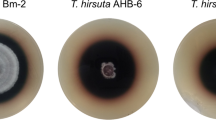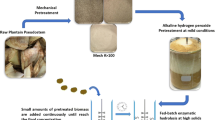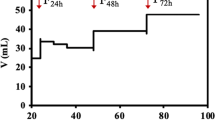Abstract
Trimming vine shoot samples were treated with water under selected operational conditions (autohydrolysis reaction) to obtain a liquid phase containing hemicellulose-decomposition products. In a further acid-catalyzed step (posthydrolysis reaction), xylooligosaccharides were converted into single sugars for the biotechnological production of lactic acid using Lactobacillus pentosus. A wide range of temperatures, reaction times, and acid concentrations were tested during the autohydrolysis–posthydrolysis process to investigate their influence on hemicellulose solubilization and reaction products. The maximum concentration of hemicellulosic sugars was achieved using autohydrolysis at 210 °C followed by posthydrolysis with 1% H2SO4 during 2 h. Data from autohydrolysis–posthydrolysis were compared with the results obtained at the optima conditions assayed for prehydrolysis (3% H2SO4 at 130 °C during 15 min) based on previous works. Prehydrolysis extracted more hemicellulosic sugars from trimming vine shoots; however, the protein content in the hydrolysates from autohydrolysis–posthydrolysis was higher. The harsher conditions assayed during the autohydrolysis process and the higher content of protein after this treatment could induce Maillard reactions decreasing consequently the concentration of hemicellulosic sugars in the hydrolysates. Therefore, despite the several advantages of autohydrolysis (less equipment caused by the absence of mineral acid, less generation of neutralized sludges, and low cost of reagents) the poor results obtained in this work with no detoxified hydrolysates (Q P = 0.36 g/L h, Q S = 0.79 g/L h, Y P/S = 0.45 g/g, Y P/Sth = 61.5 %) or charcoal-treated hydrolysates (Q P = 0.76 g/L h, Q S = 1.47 g/L h, Y P/S = 0.52 g/g, Y P/Sth = 71.5 %) suggest that prehydrolysis of trimming vine shoots with diluted H2SO4 is more attractive than autohydrolysis-posthydrolysis for obtaining lactic acid through fermentation of hemicellulosic sugars with L. pentosus. Besides the higher hemicellulosic sugars concentration achieved when using the prehydrolysis technology, no detoxification steps are required to produce efficiently lactic acid (Q P = 1.14 g/L h; Q S = 1.64 g/L h; Y P/S = 0.70 g/g; Y P/Sth = 92.6 %), even when vinification lees are used as nutrients (Q P = 0.89 g/L h; Q S = 1.54 g/L h; Y P/S = 0.58 g/g; Y P/Sth = 76.1 %).



Similar content being viewed by others
References
Kjallstrand, J., Ramnas, O., & Peterson, G. (1998). Journal of Chromatography A, 824(2), 205–210.
Tsutsui, T., Hayashi, N., Maizumi, H., Huff, J., & Barrett, J. C. (1997). Mutation Research, 373(1), 113–123.
Wen-Tien, T., & Jih-Ming, C. (2006). Chemosphere, 63, 22–30.
Domínguez, J. M., Cao, N. J., Gong, C. S., & Tsao, G. T. (1997). Bioresource Technology, 61, 85–90.
Moldes, A. B., Alonso, J. L., & Parajó, J. C. (1999). Journal of bioscience and bioengineering, 87, 787–792.
Cruz, J. M., Domínguez, J. M., Domínguez, H., & Parajó, J. C. (2000). Food Biotechnology, 14, 79–97.
Moldes, A. B., Alonso, J. L., & Parajó, J. C. (2001). Journal of Chemical Technology and Biotechnology, 76(3), 279–284.
Moldes, A. B., Cruz, J. M., Domínguez, J. M., & Parajó, J. C. (2002). Agricultural and Food Science in Finland, 11(1), 51–58.
Rivas, B., Moldes, A. B., Domínguez, J, M., & Parajó, J. C. (2004). Enzyme and Microbial Technology, 34(7), 627–634.
Garrote, G., Domínguez, H., & Parajó, J. C. (2001). Bioresource Technology, 79(2), 155–164.
Rivas, B., Domínguez, J. M., Domínguez, H., & Parajó, J. C. (2002). Enzyme and Microbial Technology, 31, 431–438.
Garrote, G., Cruz, J. M., Domínguez, H., & Parajó, J. C. (2003). Journal of Chemical Technology and Biotechnology, 78, 392–398.
Carvalheiro, F., Esteves, M. P., Parajó, J. C., Pereira, H., & Girio, F. M. (2004). Bioresource Technology, 91, 93–100.
Bustos, G., Ramírez, J. A., Garrote, G., & Vázquez, M. (2003). Applied Biochemistry and Biotechnology, 104, 51–68.
Bustos, G., Cruz, J. M., Moldes, A. B., & Domínguez, J. M. (2004). Journal of the Science of Food and Agriculture, 84, 2105–2112.
Herrera, A., Téllez-Luis, S. J., González Cabriales, J. J., Ramírez, J. A., & Vázquez, M. (2004). Journal of Food Engineering, 63(1), 103–109.
Rodriguez-Chong, A., Ramirez, J. A., Garrote, G., & Vazquez, M. (2004). Journal of Food Engineering, 61(2), 143–152.
Gámez, S., González-Cabriales, J. J., Ramírez, J. A., Garrote, G., & Vázquez, M. (2006). Journal of Food Engineering, 74(1), 78–88.
Lamptey, J. C., Robinson, C. W., & Moo-Young, M. (1985). Biotechnology Letters, 7(7), 531–536.
Mercier, P., Yerushalmi, L., Rouleau, D., & Dochain, D. (1992). Journal of Chemical Technology and Biotechnology, 55, 111–121.
Miller, T. L., & Churchill, B. W. (Ed.). (1986). Washington D.C.: American Society for Microbiology.
Bustos, G., Cruz, J. M., Moldes, A. B., & Domínguez, J. M. (2004). Journal of Agricultural and Food Chemistry, 52(16), 5233–5239.
Lowry, O. H., Rosebrough, N. J., Farr, A. L., & Randall, R. J. (1951). Journal of Biological Chemistry, 139(1), 265–275.
Rufián-Henares, J. A., & Morales, F. J. (2007). Journal of Food Quality, 30, 160–168.
Martins, S. I. F., & Van Boekel, M. A. J. S. (2003). Food Chemistry, 83, 135–142.
Jemmali, M. J. (1969). Journal of Applied Bacteriology, 32, 151–154.
Stecchini, M. L., Giavedoni, P., Sarais, I., & Lerici, C. (1993). Italian Journal of Food Sciences, 5, 51–54.
Einarsson, H., Snygg, B. G., & Eriksson, C. (1983). Journal of Agricultural and Food Chemistry, 31, 1043–1047.
Garde, A., Jonsson, G., Schmidt, A. S., & Ahring, B. K. (2002). Bioresource Technology, 81(3), 217–223.
Bustos, G., Cruz, J. M., Moldes, A. B., & Domínguez, J. M. (2004). Journal of Agricultural and Food Chemistry, 52(4), 801–808.
Acknowledgments
Authors are grateful to the following institutions for the financial support of this work: Spanish Ministry of Science and Technology (MCYT) (project PPQ2003-02802, which has partial financial support from the FEDER founds of the European Union), Xunta de Galicia (PGIDIT04PXIC38302PN and PGIDIT05BTF38301PR), and to the “Ramón y Cajal” and “Isidro Parga Pondal” programs financed by the MCYT and Xunta de Galicia of Spain, respectively.
Author information
Authors and Affiliations
Corresponding author
Rights and permissions
About this article
Cite this article
Moldes, A.B., Bustos, G., Torrado, A. et al. Comparison between Different Hydrolysis Processes of Vine-Trimming Waste to Obtain Hemicellulosic Sugars for Further Lactic Acid Conversion. Appl Biochem Biotechnol 143, 244–256 (2007). https://doi.org/10.1007/s12010-007-8021-2
Received:
Accepted:
Published:
Issue Date:
DOI: https://doi.org/10.1007/s12010-007-8021-2




